A new and groundbreaking arrangement for marine protection formalized in Seychelles
Protected areas in Seychelles have usually been managed by government entities such as the Seychelles National Parks Authority and conservation NGOs such as Nature Seychelles. Now, in an exciting turnaround, local people can get involved in managing Marine Protected Areas (MPAs) for the first time. This highly innovative project will involve the local communities around the Port Launay and Baie Ternay Marine National Parks through a co-management process that officially kicked off on 3rd December 2020 .

Dr. Nirmal Shah (R) and Mr. Selby Remy (L) signing the MoU
Photo: Nature Seychelles
Original Article published by Nature Seychelles
The two iconic marine parks, located in the Port Glaud District in the North-Western region of Mahe, the principal island of Seychelles, have been selected as the site of the first co-managed area in Seychelles through the Locally Empowered Area Protection (LEAP) Project being implemented by Nature Seychelles in Seychelles and coordinated by IUCN for the region.
The co-management process was formalised through the signing of a Cabinet of Ministers-approved Memorandum of Understanding (MoU) between Nature Seychelles, the project implementer, and the Seychelles National Parks, the designated authority for the parks, represented by Dr. Nirmal Jivan Shah and Mr. Selby Remy respectively. The Minister for Agriculture, Climate Change, and Environment, Mr. Flavien Joubert presided over the signing.
The MoU is a culmination of a lengthy and eye-opening participatory process facilitated by Nature Seychelles, which includes the coming together of local stakeholders including local fishermen, tourism establishments, entrepreneurs and vendors, government officials, youth, and district leadership to set up a site-level management committee for the project. The project was introduced to the wider community at a public gathering in September.
Co-management is a formal policy of the Seychelles government (Seychelles Protected Area Policy published in January 2013) and is set out in the upcoming Nature Reserves and Conservancy Act, the new legislation for all protected areas in Seychelles. It is defined as “A partnership in which two or more stakeholders negotiate, agree upon guarantee, and implement a shared set of management functions, benefits, and responsibilities for a particular protected area.”
 Minister Joubert addressing the gathering
Photo: Nature Seychelles
Minister Joubert addressing the gathering
Photo: Nature Seychelles
What this means in practical terms is that the project activities can begin on-site, says Dr. Nirmal Shah. "This MoU now provides a sound basis for the project to move ahead with implementing its objectives. We have both the local committee in place and the agreement with the designated authority for the two parks. It is a big milestone for the project and we are grateful to our partners who have worked to get us to this point."
The marine parks were selected by the project's National Working Group - made of senior experts and practitioners from government, civil society, and private sector - based on international and project criteria for the site. These include their importance as critical ecosystems and habitats, the potential for co-management, a supportive community as well as the potential for the development of sustainable financing mechanisms. The intention is that these coastal marine areas will be co-managed to help protect fisheries, manage ecotourism, conserve marine biodiversity, and improve local livelihoods.
Dr. Shah, the CEO of Nature Seychelles explains why the Seychelles project is different; “The original title of the project is Locally Managed Marine Area (LMMA), areas which are normally seen as community-managed sites usually not having government oversight or formal designation, and suffering from overfishing and many other problems. I have seen from experiences around the world that many of these community-based projects don’t always garner the successes promised. One of the key reasons is because they do not fit squarely in government policy and legislation and therefore other arrangements have to be made. As a result, the National Working Group wanted the project to sit in a formally designated MPA as those had policies and laws governing them. Nature Seychelles had taken part in the exercise of drawing up the policy for protected areas as it had in the drafting of the upcoming legislation, which codifies this policy so we had a clear understanding that the best chance of success was adopting the co-management regime. This is why we have wanted to formalize the process from getting the Cabinet of Ministers approving the two sites to them approving the MOU.”
 The event ended with a mangrove tour through the Ephelia Resort
Photo: Nature Seychelles
The event ended with a mangrove tour through the Ephelia Resort
Photo: Nature Seychelles
The 4-year LEAP project is funded by the German International Climate Initiative (IKI).



